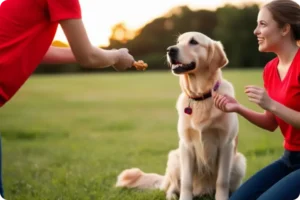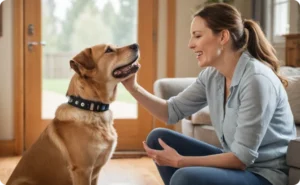Bringing home a new puppy is always an exciting experience, but the real work begins when it’s time to teach basic obedience commands. Teaching your puppy to sit is one of the first and most essential commands you can teach. This command helps establish you as the leader, making it easier to teach more advanced behaviors down the road and helping you raise a well-mannered companion.
Whether you’re a first-time pet owner or have plenty of experience with pets, this short puppy training guide will walk you through teaching your puppy to sit step-by-step using positive reinforcement methods and help you find success with your furry friend. Let’s discover the best way to teach them to sit and build a foundation for future training!
Why Teaching Your Puppy to Sit is Important
It’s important to teach the “sit” command because, while it seems simple, it’s a foundational behavior that makes it easier to teach other commands later on, improving your puppy’s overall behavior and obedience. Here’s why it should be one of the first things your puppy learns:
- Builds the Training Relationship: The basic sit command helps your puppy understand your instructions and recognize you as the leader.
- Improves Communication: It creates a bond and a relationship between you and your puppy, allowing you to understand each other.
- Safety: The sit command can prevent your puppy from making inappropriate movements around visitors or other animals, like jumping on or running around people or children.
- Foundation for Future Training: It serves as the starting point for a training foundation for other, more complex and advanced commands.
How to Teach Your Puppy to Sit: Step-by-Step Instructions
Let’s get started with the step-by-step guide to teaching your puppy to sit. We’ll be using positive reinforcement, which is very effective, but you’ll still need patience and persistence to get the final result. Let’s go!
Step 1: Gather Your Training Supplies
Start by gathering these essential items:
High-value puppy treats: Small, soft, and tasty treats to reward your puppy for a job well done.
Clicker (optional): Useful for marking the desired behavior.
Collar and leash: Helpful for keeping your puppy focused during training sessions.
Step 2: Choose the Right Environment
Select a quiet area free from distractions where your puppy feels comfortable. This will help your puppy concentrate on your cues and rewards.
Step 3: Get Your Puppy’s Attention
Before giving any command, make sure your puppy is paying attention. Use their name or a gentle sound to ensure they are looking at you and ready to learn.
Step 4: Give the “Sit” Command
Hold a treat near your puppy’s nose to get their attention. Slowly move your hand upward, causing your puppy to look up and naturally lower their rear end. As soon as your puppy’s butt hits the floor, say “Sit” in a clear voice and give the treat immediately.

Tip: If you’re using a clicker, press it the moment your puppy sits, and then offer the reward.
Step 5: Use Positive Reinforcement
Positive reinforcement means rewarding good behavior to encourage your puppy to repeat it. Give lots of praise—say “Good sit!”—and offer a treat every time your puppy successfully sits on command.
Step 6: Repeat and Practice
Practice in short training sessions (5-10 minutes) three times a day or whenever is most comfortable for you. The key is to keep the lessons consistent and brief, which prevents your puppy from getting overwhelmed or bored.
Step 7: Add Verbal and Visual Cues
Over time, start associating the verbal cue—”Sit”—with a distinct hand signal (such as an open palm facing up). This helps reinforce the connection between the command and the behavior.
Common Challenges When Teaching ‘Sit’ (and How to Overcome Them)
Puppy Won’t Sit
If your puppy isn’t responding to the sit command, don’t get frustrated. Some puppies may need time to understand the cue. Try luring your puppy with the treat again or slightly adjusting your hand motion.
Puppy Jumps Up Instead of Sitting
If your puppy jumps to get the treat, raise your hand more slowly and reward them only when they sit. Avoid pushing your puppy into the position, as this can cause confusion or discomfort.
Loses Focus Quickly
Puppies have short attention spans. Keep training sessions brief and engaging. If your puppy gets distracted, take a short break and try again later.
How Positive Reinforcement Makes Training Easier
Instead of punishing mistakes, positive reinforcement puppy training uses treats, praise, and encouragement to reward correct behaviors. This method not only speeds up learning but also builds trust between you and your puppy, leading to a more obedient and happy companion. Avoid punishment or yelling, as this can create fear and hinder progress.
Next Steps: Moving Beyond the Sit Command
Once your puppy has mastered the sit command, you can teach other basic commands like “stay,” “come,” and “down.” Always start with one command at a time to avoid overwhelming your puppy.
Integrate the “Sit” Command into Daily Life:
- Ask your puppy to sit before meals.
- Give the command before going outside, receiving treats, or meeting new people.
This repetition helps your puppy generalize the command to various situations, solidifying the behavior for life.
Frequently Asked Questions About Teaching Puppies to Sit
You can begin basic obedience training as early as 8 weeks old. Keep your approach gentle and use puppy-sized treats for the best results.
Most puppies can learn to sit within a few days to a week of consistent practice. Individual results may vary based on age, personality, and prior experiences.
Gradually reduce the frequency of treats once your puppy reliably sits on command. Replace treats with verbal praise, pets, or playtime to maintain motivation.
Conclusion
Learning how to teach your puppy to sit is an invaluable step toward raising a well-behaved pet. By using positive reinforcement, patience, and consistency, you will lay the groundwork for a strong training relationship and a lasting bond with your dog. Approach each training session as an opportunity to connect and celebrate every small success. Happy training!








